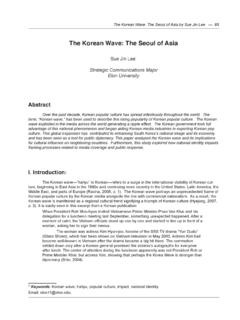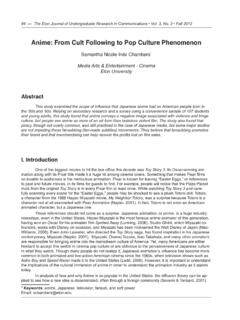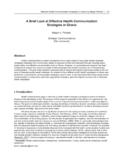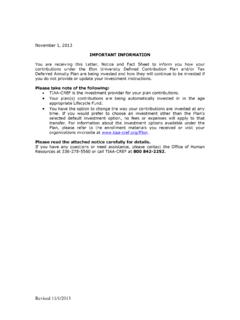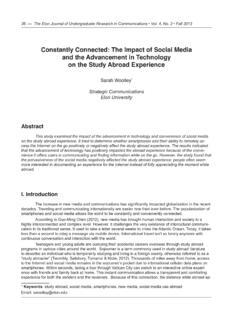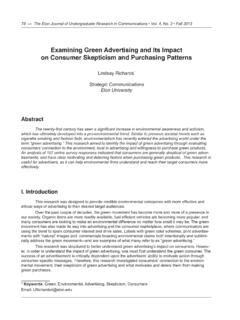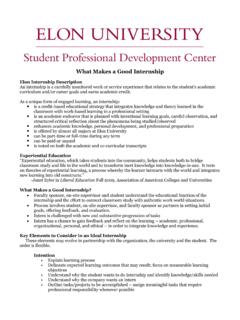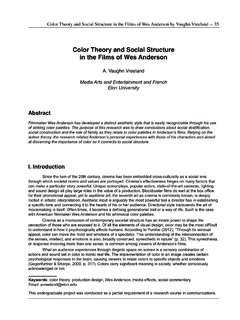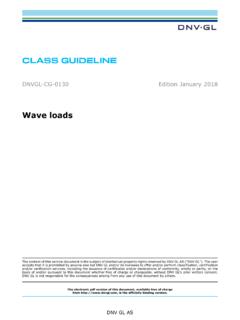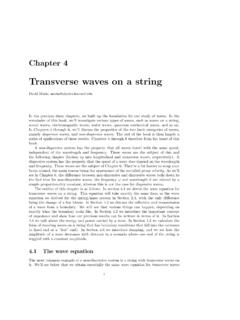Transcription of The Korean Wave: The Seoul of Asia - Elon University
1 The Korean Wave: The Seoul of Asia by Sue Jin Lee 85. The Korean Wave: The Seoul of Asia Sue Jin Lee*. Strategic Communications Major Elon University Abstract Over the past decade, Korean popular culture has spread infectiously throughout the world. The term, Korean wave, has been used to describe this rising popularity of Korean popular culture. The Korean wave exploded in the media across the world generating a ripple effect. The Korean government took full advantage of this national phenomenon and began aiding Korean media industries in exporting Korean pop culture. This global expansion has contributed to enhancing South Korea's national image and its economy and has been seen as a tool for public diplomacy. This paper analyzed the Korean wave and its implications for cultural influence on neighboring countries. Furthermore, this study explored how national identity impacts framing processes related to media coverage and public response.
2 I. Introduction: The Korean wave hallyu in Korean refers to a surge in the international visibility of Korean cul- ture, beginning in East Asia in the 1990s and continuing more recently in the United States, Latin America, the Middle East, and parts of Europe (Ravina, 2008, p. 1). The Korean wave portrays an unprecedented frame of Korean popular culture by the Korean media alongside the line with commercial nationalism. As a result, the Korean wave is manifested as a regional cultural trend signifying a triumph of Korean culture (Hyejung, 2007, p. 3). It is easily seen in this excerpt from a Korean publication: When President Roh Moo-hyun invited Vietnamese Prime Minister Phan Van Khai and his delegation for a luncheon meeting last September, something unexpected happened. After a moment of calm, the Vietnam officials stood up one by one and started to line up in front of a woman, asking her to sign their menus.
3 The woman was actress Kim Hyun-joo, heroine of the SBS TV drama Yuri Gudu . (Glass Shoes), which had been shown on Vietnam television in May 2003. Actress Kim had become well-known in Vietnam after the drama became a big hit there. The commotion settled down only after a Korean general promised the actress's autographs for everyone after lunch. The center of attention during the luncheon apparently was not President Roh or Prime Minister Khai, but actress Kim, showing that perhaps the Korea Wave is stronger than diplomacy (Shin, 2004). * Keywords: Korean wave, hallyu, popular culture, impact, national identity Email: 86 The Elon Journal of Undergraduate Research in Communications Vol. 2, No. 1 Spring 2011. II. Literature Review The Korean wave refers to the significantly increased popularity of South Korean culture around the world; it is also referred to as hallyu, in the Korean language. The term was coined in China in mid-1999 by Beijing journalists surprised by the fast growing popularity of Korean entertainment and culture in China (Kim, 2007, p.)
4 15). Broadly speaking, it can be said that the popularity of Korean pop music and television soap operas in China and Taiwan sparked the Korean wave abroad. The outbreak of hallyu can be traced back to 1997, when the Korean TV drama, What Is Love All About, broadcast on state-run Chinese television, CCTV, set the stage for hallyu in China, following an MBC-TV drama, Jealous, which was imported as the first popu- lar cultural product from South Korea in 1993 (Kim, 2007, p. 15). Since then, the boom of Korean popular cul- ture in the neighboring Asian countries has remarkably increased and significantly penetrated them over the past several years, and in the years 2000 through 2002, according to one source, the Korean wave moved forward to diverse parts of Asia, including Southeast and Central Asia, and therefore this wave reached an active penetration stage (Hyejung, 2007, p. 6). Interestingly, though every country in Asia had a common reaction toward the Korean wave at first, each had a slightly different outlook.
5 This is because each country has a different ethos, and based on this, its audience decodes and responds to cultural products in different ways (Kim, 2007, p. 24). For example, in Taiwan, Daejangguem had the best reception of any Korean drama, whereas in Japan, Korea Herald was most popular (Kim, 2007, p. 24). The trend soon spread out from the mainland to Taiwan, Hong Kong, af- fecting ethnic Chinese in other Asian countries and eventually Japan, leading all these Asian peoples to be fascinated by not only Korean music and drama, but also its films, food and fashion. Accordingly, Korean cultural products have become a catalyst for curiosity about Korean culture and Korea itself. Korean dramas in particular have served as an important bridge for the different countries to encounter Korean culture. The appeal of Korean pop culture to Asians is especially meaningful for the Korean government since the country's national image has not always been positive in neighboring countries (Doobo, 2006, p.)
6 6). Many Asian countries have been distant from their closest neighbors in terms of cultural understand- ing and exchanges, and instead have had a tendency to link more closely to the former colonial empires or advanced Western countries than with neighbors sharing borders (Ryoo, 2007, p. 144). The impact of the Korean wave has not only permeated popular culture but is also a measure of positive lifestyle for many Asian people (Ryoo, 2008, p. 144). Many Asians did not know much about South Korea or knew only a few simple, often stereotypical things about South Korea. Images associated with South Korea were negative and related to events such as the Korean War, cycles of poverty and political instability (Lee, 2007, p. 29). These negative images have diminished dramatically due to trendy entertainers, new technology, and the image of contemporary South Korean lives through dramas and movies. Rhoo wrote, Regional cultural affinities also help explain this phenomenon in the sense that the success of the Korean wave is closely related to the ability of South Korean culture and media to translate Western or American culture to fit Asian taste (2007, p.
7 45). Western popular cultural artifacts will not likely succeed because of a certain non-negotiable cultural heterogeneity, Rhoo predicted ( 2007, p. 45). South Korean popular culture is much more readily relatable and accepted to Asian audiences. The cultural affin- ity between South Korea and neighboring countries in the region may thus function as an effective bridge or buffer between the West and Asia (Ryoo, 2007, p. 145). South Korean television shows and movies portray themes that Asian audiences can relate to more easily than those of Western entertainment because Korean dramas typically deal with family issues, love and filial piety in an age of changing technology, and often rein- forces traditional values of Confucianism (Ryoo, 2007, p. 140). Observers generally agree that the most likely explanations for the popularity of South Korean shows, singers, and movies throughout Asia include South Korea's high income levels, the close cultural proximity and affinity they share with neighboring Asian countries (Ryoo, 2007, p.
8 140). As a result of these and other economic developments, South Korea is now the twelfth largest economy in the world, and its entertainment companies are able to finance shows and movies with production values much higher than in most of Asia . (Ryoo, 2007, p. 140). As seen above, the Korean wave has had a marked impact in various ways regarding transaction with other countries. Local sentiment towards Korea has not been respectable in the past, but the Korean wave has fundamentally changed the national image of Korea in a positive way. The Korean wave ultimately improved Korea's image in foreign countries, which in turn created a ripple effect that has extended much The Korean Wave: The Seoul of Asia by Sue Jin Lee 87. farther than just the Korean economy or peninsula. Such a fast change in the economic and cultural status of Korea raises important questions regard- ing the Korean wave and how it is covered in the media.
9 This paper will examine this Korean experience as a primary case in which various political, cultural, economic, and historical factors are at play in shaping the perception of a nation. III. Method For a critical analysis of how the Korean wave has been depicted in the media, the author reviewed scholarly studies on the topic and analyzed prominent newspapers from different countries. Sources included academic journals, news articles, edited books, websites, and newspapers. Research was also conducted for qualitative data by face-to-face and phone interviews. The author s research focused on a comparative framing analysis on the Korean wave from , Asian, and Korean newspapers. Only major newspapers were selected based on their national reputation in each country: Korea Herald, Korea Herald (Singapore), Korea Herald (Thailand) and Korea Herald (Tokyo). Articles were collected from online archives with the searching keywords of Korean Wave.
10 After the author narrowed her search, 84 newspaper articles were selected. IV. Findings Scholars have determined that Communication research today demonstrates that media can and do influence societies, cultures and identities (Reason and Respect, 2007). National identity is not only embed- ded in everyday news coverage but also explicit when international news, to which a nation is related either directly or indirectly, is reported (Reason and Respect, 2007). The conditions that made the recent success of Korean pop culture possible are examined in the context of news frames. To frame is to select some aspects of a perceived reality and make them more salient in a communication text described, moral evaluation, and/. or treatment recommendation for the item described (Entman, 1993, p. 391). Generally speaking, news framing is the process of filtering and transmitting news through an angle or frame' in order to support specific ideologies, stimulate widespread attention or persuade an audience (Entman, 1993, p.)
